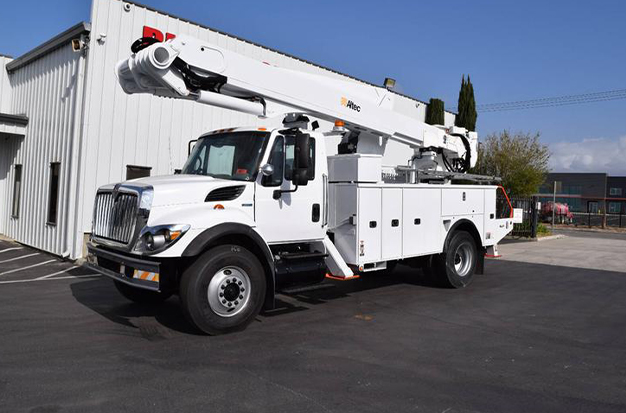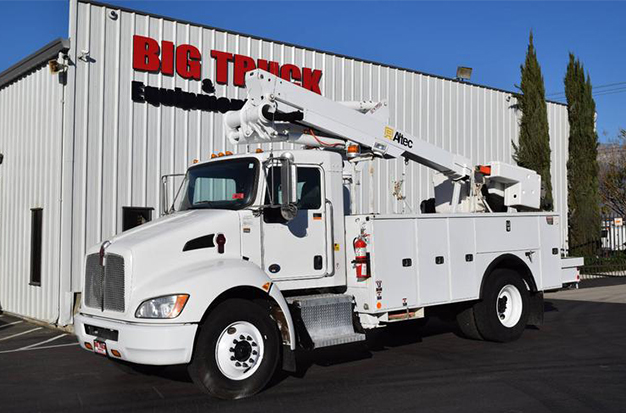A bucket truck weighs how much, exactly? A bucket truck is a unique utility vehicle that features an aerial work platform. Bucket trucks are used by a variety of industries to transport workers to work-related heights. This article’s main goal was to respond to the following query: “A bucket truck’s weight is how much?”
Bucket trucks can weigh anywhere between 10,000 pounds (4,500 kg) and 84,000 pounds (38,000 kg), depending on their size and type. The maximum safe weight of the truck with all of its loads is expressed in these numbers as gross vehicle weight ratings (GVWR).
Why is the weight of bucket trucks so important, and why is the weight range so wide? Determine which one would work best for your company’s requirements by reading on.
History Of Bucket Trucks
Early in the 20th century, the bucket truck design was developed. Internal combustion engines started to become more and more common during this time.
The bucket truck was first applied in the agricultural sector, more specifically in the sector of fruit harvesting. Many orchard workers were submitting compensation claims for mishaps that occurred as they used ladders to harvest fruit from tall trees.
To speed up, simplify, and increase safety during harvesting, people eventually began employing trucks with aerial work platforms (AWP). The “cherry picker” moniker stuck with this early design, and some bucket lifts still go by this name today.
When other industries learned about the benefits of the cherry picker, they eventually began utilizing the same invention for their own purposes. These industries include:
- Electric utility
- Forestry
- Mining
- Construction
- Home improvements
Since then, bucket truck designs have improved in terms of capacity, effectiveness, and safety, but the fundamental duties have remained the same.
Types Of Bucket Truck
The shapes, sizes, and weights of bucket trucks vary widely. The following bucket truck models fall under the three main bucket truck categories: Telesquirt, Material Handler, Overcenter and Non-overcenter, Insulated and Non-Insulated, Track Bucket, and Articulating.
Telesquirt Bucket Trucks
Unlike the articulated versions, these trucks’ straight booms have no knuckles and can only extend telescopically.
One of the best features of telescopic bucket trucks is that they have a longer horizontal reach than any other boom. Working in locations with limited access benefits greatly from this feature.
Material Handler Bucket Trucks
These trucks are made to carry a reasonable amount of cargo without the need for elaborate rigging or additional equipment, making them perfect for use with multiple lifting workers.
Articulating Boom Lift Truck
Also known as “squirt booms” due to their unusual ability to unfold like knuckle booms with an additional telescopic function. As a result, there is less tail swing on the side opposite from where the work is being done, allowing for greater side reach at higher elevations.
In many cases, this type of design restricts how often your bucket truck must be relocated, resulting in increased productivity e.g The Terex LT40 and the Versalift VST-7500-E108
Insulated Bucket Trucks
Insulated bucket trucks are most frequently used by utility workers and people who handle electrical cable. These automobiles use dielectric materials in two parts to help prevent accidental electrocution: the boom and bucket.
Non-insulated Bucket Trucks
Two non-insulated bucket trucks without fiberglass covering on their booms and buckets are the Posi-Plus 800 and Versalift SST-36-NE. They offer no defense against electric shock. The only material used to build them is steel.
Overcenter Bucket Trucks
Another type of vehicle with an articulated design is overcenter bucket trucks. In forestry, utility, and construction work, overcenter booms enable the bucket to move outside the truck’s center while extending the side reach.
Non-overcenter Bucket Trucks
Non-overcenter bucket trucks have a smaller reach because they can’t move the bucket past the center of the truck. However, if working height is your primary concern, for instance,, as with It’s not always necessary to use a Terex TC55 or TM125.
The Importance Of Weight
The majority of bucket trucks weigh a lot. They resemble forklifts, which is the reason why.
When used to lift heavy objects, they must be heavy to prevent tipping.
Therefore, bucket truck weight is crucial for work because it enables safe operation without risking worker falls.
The good news is that weight is not a big concern when using a bucket truck.
This is due to the fact that manufacturers always calculate and test everything.
Therefore, it is extremely unlikely that using a bucket truck will put you in any danger as long as you abide by the weight limit on the bucket and other safety requirements.
Bucket Capacity
The maximum weight that a bucket can safely carry is referred to as its capacity, and the weight varies significantly between different bucket trucks of various sizes. Between 400 pounds (181 kilograms) and 2,000 pounds (907 kilograms), on average, are the bucket capacities.
Due to stability and safety concerns, bucket capacity typically decreases as the boom extension or reach increases.
Platform Height/reach
Different bucket trucks are made for various vertical and horizontal reaches, and these specifications are heavily industry-specific. Typical platform height categories include:
- 29 to 45 feet – These are frequently used for telecommunications and electrical grid maintenance because local utility poles are typically 40 feet tall. They are also helpful for rescue efforts, window cleaning services, and home repairs.
- 45 to 65 feet – These are medium- to heavy-duty trucks that can be utilized for tree work and for maintaining some electricity distribution lines.
- 65 to 100 feet – Most of the trees in North America can be accessed by these bucket trucks, as well as almost all utility poles. In fleet operations, they are also helpful.
- Utility workers can now access areas that would otherwise require a helicopter thanks to these high-reach trucks, which have a reach of over 100 feet. They are frequently employed to maintain wind energy facilities.
The Bronto Skylift Model SI 219 HDT-C bucket truck is currently the highest-reaching bucket truck that is commercially available. This truck has a 219-foot (67-meter) platform height and a 89-foot (27-meter) horizontal reach.
On the other hand, the same company asserts that its 367-foot-tall exhibition model is its highest-reaching model.

How Can I Lighten The Weight Of My Bucket Truck?
There are a few ways to lighten the load on your bucket truck:
- Instead of using steel for the bucket, choose a lighter material like plastic.
- Make your engine smaller. Since it uses less fuel, a smaller engine will be lighter.
- Contrary to popular belief, a manual transmission is preferable. Contrary to automatic transmissions, manual transmissions are frequently lighter.
What Should You Consider When Purchasing A Bucket Truck?
Platform Capacity
When purchasing a bucket truck, it’s crucial to take its weight into account. The truck’s weight will affect how much it can carry and how it handles on the road.
The weight of the bucket truck will vary depending on a number of variables. The bucket’s dimensions come first. The truck will weigh more the bigger the bucket is. The material of the bucket is the second consideration.
More weight will be carried by a steel bucket than by a plastic one. Finally, the truck’s weight will also depend on the engine type. Compared to a gasoline engine, a diesel one will be substantially heavier.
Engine Type
The type of engine is something else to think about when buying a bucket truck. The two main categories of engines are gasoline and diesel. Typically, gasoline engines are smaller and use less fuel. Diesel engines can cost more to maintain but are heavier and have more torque.
The weight of the truck will also depend on the size of the engine. More so than a bigger engine, a smaller one will be lighter.
Tailgate Type
Another aspect to take into account when buying a bucket truck is the type of tailgate. Lift-up and swing-away tailgates are the two main varieties. Typically, swing-away tailgates weigh more than lift-up tailgates.
The weight of the truck will also be influenced by the material of the tailgate. A steel tailgate will weigh much more than a plastic one.
Transmission Type
A further element that will impact the bucket truck’s weight is the type of transmission. Transmissions generally come in two flavors: automatic and manual. In general, automatic transmissions weigh more than manual transmissions.
The bucket truck’s weight will also be influenced by the drive system type. A truck with rear-wheel drive will weigh more than a truck with front-wheel drive.
Side-reach
When buying a bucket truck, you should also think about the side-reach. The bucket’s ability to reach the side will be limited by its side-reach. The truck’s weight increases with the side-reach.
Working Height
The working height is the last aspect to take into account before buying a bucket truck. The bucket’s maximum height will depend on its working height. The truck will be heavier as the working height increases.
Buying VS. Renting Bucket Trucks
Bucket trucks are specialized vehicles, so it makes sense that they are quite expensive. New heavy-duty bucket trucks can run as much as $450,000, while new light-duty ones can cost anywhere from $40,000 to $150,000.
It might be a good idea to buy a bucket truck if your business frequently uses them to provide its services. Consider renting a bucket truck, though, if you only need one or use one occasionally.
The cost of renting a bucket truck can vary depending on the time of year, the location, and the type of truck itself. Rental fees for bucket trucks typically range from $600 per day to $1,800 per week to $5,200 per month.
Conclusion
The size, material, and type of engine all affect how much a bucket truck weighs. Other factors to consider include the bucket’s weight.
Bucket trucks are typically categorized as class 5 trucks and can weigh up to 19,500 pounds, though there are some exceptions.
